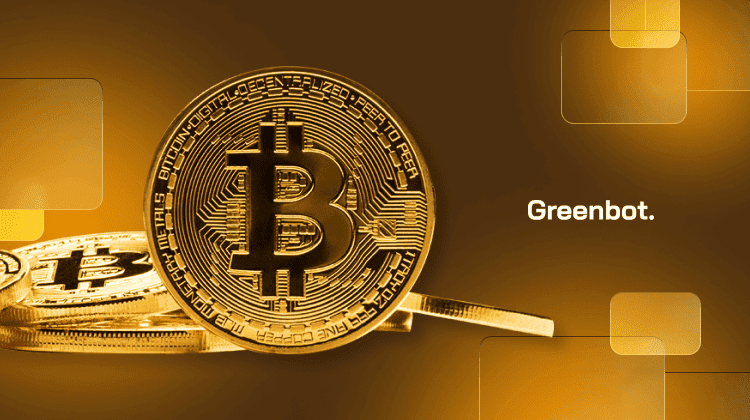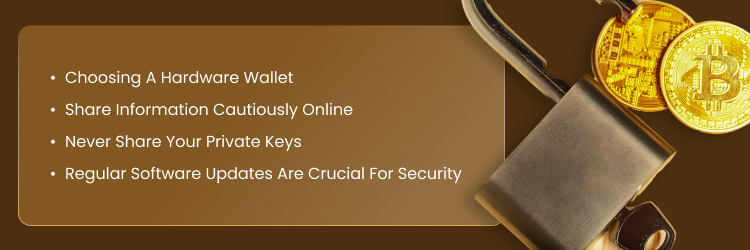
Bitcoin is the first decentralized digital currency. It was introduced in 2008 by an anonymous creator, Satoshi Nakamoto. It allows people to send and receive money without banks or governments.
Bitcoin uses blockchain technology to record transactions in a public ledger. The system stops fraud, such as double spending, and removes the need for central authorities. Over time, Bitcoin became popular for its low costs and ability to help people without access to banking systems.
In this guide, we look into what bitcoin is, its history, uses, and more. We will also explain Bitcoin’s role in revolutionizing digital transactions.
Let’s get started.
What Is Bitcoin?

Bitcoin (BTC) was launched in 2009 as the first operational cryptocurrency. It works entirely online and doesn’t rely on banks or governments. Instead, Bitcoin uses a global peer-to-peer network to allow secure and direct money transfers.
Bitcoin’s foundation is blockchain technology, a decentralized ledger that tracks every transaction. It ensures transparency, prevents fraud, and makes each transaction permanent. Without intermediaries, Bitcoin offers faster and more reliable ways to send money.
Bitcoin isn’t just for payments. It’s also a limited digital asset, with 21 million coins. This scarcity adds to its value and appeal as an investment. Many use Bitcoin for affordable international transfers or to protect against inflation. It continues to influence modern finance and inspire innovation.
The History of Bitcoin
Bitcoin began in 2008 when Satoshi Nakamoto published a whitepaper called Bitcoin: A Peer-to-Peer Electronic Cash System. The document proposed a decentralized currency free from banks or governments. In January 2009, Nakamoto mined the Genesis Block. Embedded in it was the message: “The Times 03/Jan/2009 Chancellor on brink of second bailout for banks.” This marked Bitcoin’s start as a response to financial crises.
In 2010, Bitcoin was first used in a commercial transaction. A user paid 10,000 BTC for two pizzas, an event now known as Bitcoin Pizza Day. Bitcoin grew in niche communities and platforms like Silk Road during its early years. The platform was known for enabling anonymous transactions. In 2012, Nakamoto transferred control to developers. That same year, the Bitcoin Foundation was formed to promote wider adoption.
Between 2013 and 2019, Bitcoin moved from niche adoption to becoming a recognized financial asset. During this period, governments began regulating cryptocurrencies. The U.S. introduced guidelines, while China altogether banned their use. In 2017, SegWit improved scalability, and Bitcoin Cash emerged as a fork. Bitcoin also gained institutional interest when futures trading launched on the CME. Volatility persisted, driven by exchange hacks and regulatory challenges.
Since 2020, Bitcoin’s mainstream adoption has surged. Companies like Tesla and PayPal began accepting Bitcoin, showcasing corporate acceptance. In 2021, El Salvador became the first country to adopt it as a legal tender. Institutional investments and upgrades like Taproot further enhanced its functionality. By 2024, Bitcoin reached $100,000, solidifying its place as a global financial asset.
How Does Bitcoin Work?

Bitcoin is a decentralized digital currency that works without banks or governments. Its backbone is blockchain technology, a public ledger that records all transactions transparently. Unlike traditional banks, the blockchain is maintained by a global network of computers. This prevents any single entity from controlling or tampering with it. The system prevents fraud, double spending, and centralization.
Bitcoin transactions are verified through a process called mining. Miners use powerful computers to solve mathematical puzzles. Validated transactions are added to the blockchain. As a reward, miners receive newly created bitcoins. This reward is halved about every four years, a process known as halving. The total supply is capped at 21 million bitcoins. Experts estimate the last bitcoin will be mined in 2140, ensuring scarcity.
When users send Bitcoin, transactions happen directly between parties through a peer-to-peer network. The network uses cryptographic protocols to verify these transactions. This ensures accuracy and security without intermediaries. Transactions are irreversible and visible on the blockchain. However, users remain anonymous through unique wallet addresses, maintaining their privacy.
Bitcoin’s value depends on scarcity, divisibility, and adoption. It can be divided into smaller units called Satoshis, making it suitable for small transactions. Today, Bitcoin is used for online payments, international transfers, and as an investment. Its decentralized and transparent design is reshaping how people view and use money.
Blockchain Technology Explained
Blockchain technology powers Bitcoin, ensuring security, transparency, and decentralization. This is the essence of cryptocurrency in digital finance. It’s a digital ledger that records transactions across a global network of computers called nodes. Unlike traditional systems, no single authority controls the blockchain. Each node holds a copy of the ledger, and all updates are synchronized, ensuring accuracy. This design prevents tampering or fraud, making the system highly reliable.
A blockchain is made up of individual blocks. Each block contains transaction data, a timestamp, and a unique block hash identifier. Blocks are connected in chronological order, forming a chain. Key components include the coinbase transaction (miner rewards) and the Merkle root (a summary of all transactions in the block). Altering one block would require changing the entire chain, making fraud nearly impossible.
Bitcoin’s blockchain uses Proof of Work (PoW) to validate transactions and add new blocks. Miners compete to solve mathematical puzzles, ensuring consensus among participants. This process eliminates the need for intermediaries, reducing costs and increasing trust. The decentralized structure ensures no single party can control the ledger. This feature has made blockchain essential for Bitcoin and some industries. These include finance, healthcare, and logistics.
How to Use Bitcoin

You first need a cryptocurrency wallet to store and manage your funds to use Bitcoin. Wallets are your interface with the Bitcoin blockchain. They securely store your private keys, which are needed to authorize transactions. Wallets come in different types, such as mobile apps, hardware devices, and online platforms. Each type offers varying levels of convenience and security.
Once you have the best crypto wallet for your needs, you can acquire Bitcoin through exchanges, peer-to-peer platforms, or Bitcoin ATMs. You can buy Bitcoin on cryptocurrency exchanges using fiat currencies like USD or EUR. Bitcoin ATMs allow you to convert cash into Bitcoin easily. Peer-to-peer platforms let you transact directly with sellers. After acquiring Bitcoin, you can track your balance and transaction history using your wallet.
Bitcoin can be spent at online stores, physical retailers, and service providers that accept it. Transactions are simple. Enter the vendor’s wallet address and payment amount using your wallet app, or scan a QR code for faster input. You can also sell Bitcoin for cash or hold it as part of your investment strategy. Its flexibility allows you to use it for purchases, transfers, or savings.
Investing in Bitcoin
Bitcoin offers unique opportunities for investors. It has growth potential, diversification benefits, and a low correlation with traditional assets. Since its creation in 2008, Bitcoin has become popular among short-term traders and long-term investors. Its decentralized nature, limited supply, and global adoption make it a valuable asset in modern portfolios.
One of Bitcoin’s biggest strengths is its historical performance. In the past decade, it has beaten traditional investments, including Apple and Tesla stocks. This growth stems from rising adoption, technological progress, and its role as a digital store of value. However, investors should note that past performance does not guarantee future results. Bitcoin remains highly volatile.
Bitcoin balances diversified portfolios. Its low correlation with traditional assets, such as stocks and bonds, makes it a helpful tool for reducing risk. Bitcoin’s value depends on unique factors, including market sentiment and technological updates. Thus, it aligns with modern portfolio theory, which emphasizes reducing risk by diversifying.
Investors must also consider the risks of Bitcoin. They include price volatility, regulatory changes, and cybersecurity issues. To succeed, investors should research thoroughly and prepare for market fluctuations. With careful planning, Bitcoin can provide growth and diversification.
Risks and Considerations
One of Bitcoin’s biggest risks is its volatility. Its price can swing sharply due to market sentiment, economic events, or regulatory news. For example, interest rate hikes or major exchange failures have caused sudden price drops. Unlike traditional assets, Bitcoin is too unstable for extreme price changes. This makes it a very speculative investment.
Regulatory concerns also pose challenges for Bitcoin. Countries like China have banned Bitcoin-related activities, while others impose strict trading rules. These actions heavily influence Bitcoin’s price and adoption. On the positive side, developments like Bitcoin ETF approvals can boost demand and investor confidence. Still, global regulatory uncertainty continues to create instability in the market.
Security is another critical issue for Bitcoin users. Unlike bank accounts, Bitcoin wallets are not insured. Hacks, such as the 2014 Mt. Gox breach, exposed the risks of storing funds on exchanges. Hardware wallets offer more security but come with risks like loss or damage.
Legal and Regulatory Environment

The legal status of Bitcoin varies worldwide. In the United States, it is classified as property and regulated under existing laws. The SEC treats it as a commodity, while the IRS enforces tax rules. In 2023, Europe introduced the Markets in Crypto Assets (MiCA) regulation to create consistent rules across the EU. In contrast, China banned Bitcoin-related activities, citing economic risks.
Regulatory actions directly impact Bitcoin adoption. Positive steps, like Bitcoin ETF approvals, boost investor confidence and increase mainstream use. However, unclear policies, like India’s delayed crypto laws, create uncertainty. Balanced regulations are essential to encourage innovation while protecting consumers.
Security and compliance remain major concerns in Bitcoin regulation. Its decentralized and global nature makes law enforcement difficult. Problems like money laundering, tax evasion, and cybercrime add to the challenges. To boost Bitcoin’s acceptance, regulations must address risks. They should foster trust and innovation, too.
Bitcoin vs. Traditional Currency
Bitcoin and fiat currencies serve as mediums of exchange but differ in key ways. Fiat currencies are issued by governments and managed by central banks, ensuring control over supply and value. Bitcoin, on the other hand, operates on a decentralized blockchain. It relies on a global network of users to verify transactions, removing the need for intermediaries.
In terms of usage, fiat currencies dominate everyday spending. Banks and payment systems handle fiat transfers, ensuring speed and reliability. Bitcoin offers a peer-to-peer system that supports direct transactions. Users can send payments by entering wallet addresses or scanning QR codes. This makes Bitcoin appealing to those who value financial independence. It also benefits those who want to explore how to use Bitcoin for various purposes.
Fiat currencies, controlled by governments, face inflation risks. They have an unlimited supply, which makes them poor for storing value. With its fixed supply of 21 million coins, Bitcoin avoids inflation but is more volatile. Its price swings make it less stable for saving compared to fiat currencies. Still, Bitcoin provides an alternative for those seeking decentralized financial solutions.
The Future of Bitcoin
The cryptocurrency market is projected to grow from $51.5 billion in 2024 to $71.7 billion by 2028. Bitcoin plays a central role in this expansion. Its future depends on new technologies and increased adoption. Innovations like the Lightning Network aim to improve transaction speed and scalability. Machine learning (ML) may also strengthen blockchain security and detect fraud.
El Salvador has adopted Bitcoin as a legal tender. This move sparked global interest and debate about its economic potential. Such steps boost adoption, but challenges remain. Regulatory uncertainty and price volatility are key obstacles. Overcoming these issues is essential for Bitcoin’s long-term success.
Bitcoin’s role continues to evolve as more people and institutions use it. It is seen as a store of value, like gold, and a medium of exchange competing with the US dollar. Bitcoin miners and spot Bitcoin ETFs could strengthen its position in global markets. Its future depends on tech progress and the market’s adaptation to its decentralized framework.
Bitcoin and the Global Economy
Bitcoin is revolutionizing global finance. It allows borderless payments and removes intermediaries. This reduces currency exchange fees, making trade and remittances faster and cheaper.
Bitcoin’s decentralized design promotes financial inclusion. It helps people in areas without access to traditional banking. For remittances, it offers a secure and affordable way to send money. Transactions are quicker and cost less, benefiting underserved communities.
However, challenges remain. Price volatility and regulatory scrutiny are key concerns. Governments are working to regulate cryptocurrencies without halting innovation. As Bitcoin adoption grows, it could help build a more inclusive and efficient financial system.
How to Secure Your Bitcoin

Securing your Bitcoin requires a proactive approach. Start by choosing a hardware wallet, widely regarded as the safest option. These devices store your private keys offline, keeping them out of reach from hackers. Always back up your wallet. If possible, store recovery phrases securely in multiple physical locations.
To avoid scams, share information cautiously online. Be wary of phishing emails, fraudulent websites, and unsolicited offers. Double-check URLs before logging into wallets or exchanges. Never share your private keys or recovery phrases, even if requested by someone posing as support personnel.
Regular software updates are crucial for security. Updates often patch vulnerabilities, ensuring your wallet remains protected against new threats. Use strong, unique passwords for your accounts and enable two-factor authentication wherever possible. By following these best practices, you can safeguard your Bitcoin and minimize the risk of loss or theft.
Common Myths About Bitcoin
- Bitcoin is Only Used for Illegal Activities: Many believe criminals mainly use Bitcoin. However, reports like Chainalysis 2024 show that less than 0.34% of crypto transactions are tied to illicit activities. By contrast, fiat currencies are responsible for most illegal financial activities worldwide.
- Bitcoin Has No Practical Use: Critics argue Bitcoin lacks utility. In reality, it enables global payments without intermediaries and speeds up transactions. It is also increasingly used as a hedge against inflation. Major companies like Tesla and MicroStrategy have adopted Bitcoin for asset management.
- Bitcoin is an Environmental Hazard: Mining Bitcoin consumes significant energy, but much comes from renewable sources such as hydro, wind, and solar power. Studies show that Bitcoin’s energy efficiency surpasses that of traditional banking and gold mining. It also fosters innovation in sustainable energy solutions.
- Bitcoin’s Value is Based on Nothing: Bitcoin’s value stems from its scarcity, capped at 21 million coins, and growing global adoption. Its supply is hard-coded, making it resistant to inflation. This characteristic makes Bitcoin a reliable store of value compared to fiat currencies.
- Competitors Will Replace Bitcoin: New cryptocurrencies emerge frequently, but Bitcoin remains the market leader. It has the largest adoption and market cap in the crypto world. Its decentralized and adaptable nature ensures it evolves to maintain dominance over competitors.
Bitcoin Mining: An Overview
Bitcoin mining verifies transactions and adds them to the distributed digital ledger blockchain. Miners solve complex problems as part of this process. This ensures the network remains secure, with transactions validated and tamper-proof. This decentralized process is vital to Bitcoin’s security and functionality.
Miners earn Bitcoin rewards for adding new blocks to the blockchain. These rewards motivate miners and control Bitcoin’s supply. However, mining has become competitive. It now requires specialized hardware and a lot of energy to be profitable.
Mining pools allow participants to combine computing power, improving their chances of success. This collaborative approach effectively addresses the challenges of mining. It shows how Bitcoin mining evolves with better energy use and hardware.
Environmental Impact of Bitcoin Mining
Bitcoin mining requires significant energy, raising concerns about its environmental impact. The process often relies on electricity from fossil fuels, contributing to carbon emissions. As mining expands globally, concerns have grown. This highlights the need for sustainable practices.
A shift toward renewable energy sources is addressing this issue. Many mining operations now use hydroelectric power to reduce their carbon footprint. Wind and solar energy are also becoming popular choices for sustainable mining. Reports suggest a significant portion of Bitcoin mining already relies on clean energy sources.
Innovations in energy-efficient hardware and carbon-neutral strategies further support sustainable mining. Governments and industries are also encouraging greener practices through incentives and regulations. These solutions can make Bitcoin mining more eco-friendly.
How AI is Shaping the Future of Cryptocurrency

AI is transforming cryptocurrency by improving trading strategies, security, and scalability. Understanding what AI is provides essential context for its impact.
AI-Driven Trading
AI trading algorithms analyze market trends, historical data, and social media sentiment. These insights help predict price movements with impressive accuracy. Using AI-powered tools, traders can respond to changes in real time. For instance, automated bots trade faster than humans. They reduce errors and optimize profits. Companies like Binance use AI to navigate volatile markets, showcasing its critical role. These tools empower data-driven decisions in unpredictable crypto environments.
Enhanced Security with AI
AI is addressing security challenges in cryptocurrency. Machine learning monitors blockchain networks for unauthorized transactions and unusual activity. This early detection helps prevent fraud. For example, AI has boosted security in decentralized finance (DeFi) platforms. Real-time threat detection protects blockchain integrity. It makes digital transactions safer and reduces risks for users.
Blockchain Optimization
AI boosts blockchain scalability and transaction efficiency. It streamlines verification processes, reducing delays and improving speed. Energy-efficient consensus mechanisms designed with AI address environmental concerns. These solutions are already making a difference in blockchain networks like Bitcoin. AI-driven energy optimizations lower costs and make cryptosystems more sustainable. Real-world applications prove the value of AI in enhancing blockchain operations.
Alternatives to Bitcoin
Bitcoin dominates the crypto markets. But, several alternatives, or “altcoins,” have emerged. Here are five prominent Bitcoin alternatives:
- Ethereum (ETH): Ethereum launched in 2015 and introduced smart contracts to the crypto world. These allow developers to build decentralized applications (DApps) on their blockchain. Transactions on Ethereum are faster than Bitcoin, completing in seconds instead of minutes. It is the second-largest cryptocurrency by market cap and a top choice for blockchain projects.
- Litecoin (LTC): Charlie Lee created Litecoin in 2011 as a faster and lighter alternative to Bitcoin. It processes transactions in just 2.5 minutes, compared to Bitcoin’s 10 minutes. With its focus on speed and lower transaction costs, Litecoin remains a trusted digital currency.
- Ripple (XRP): Ripple simplifies international payments by partnering with financial institutions. Unlike Bitcoin, Ripple uses a more centralized model. Transactions are processed in seconds, making it ideal for cross-border transfers. Institutions like American Express already use Ripple for global transactions.
- Binance Coin (BNB): Binance Coin debuted in 2017 as a utility token for the Binance exchange. Initially, it offered discounts on trading fees. Today, it supports payments and other applications beyond the platform. Backed by Binance, one of the largest exchanges, Binance Coin is a strong player in the market.
- Cardano (ADA). Cardano, launched in 2017, is a third-generation blockchain. It addresses scalability, sustainability, and interoperability issues found in earlier blockchains. Its advanced technology makes it popular for international transactions and blockchain innovation.
- Dogecoin (DOGE): Originally a meme cryptocurrency, Dogecoin has grown into a significant altcoin with a strong community and widespread appeal. Known for its simplicity and viral nature, Dogecoin has been used for tipping, donations, and even payments. However, its speculative nature makes it highly volatile.
How to Buy Bitcoin
- Step 1: Choose a Crypto-Trading Platform To buy Bitcoin, you can select a crypto-trading platform. Options include centralized exchanges like Coinbase and Binance or decentralized exchanges for anonymity. Centralized exchanges require IDs and follow regulations. Decentralized ones allow pseudo-anonymous transactions. To secure financial transactions, use strong passwords and two-factor authentication.
- Step 2: Connect a Payment Method Link your account to a payment method, such as a bank account, debit, or credit card. Credit card transactions may incur higher fees and interest. Some banks may restrict payments to crypto exchanges, so check beforehand. You can buy one Bitcoin or smaller amounts based on your budget.
- Step 3: Place an Order Decide how much Bitcoin to buy. Exchanges offer market orders for instant purchases and limit orders to set a specific price. Platforms like Coinbase also allow recurring purchases. These features make investing in the entire Bitcoin network more accessible and efficient.
- Step 4: Secure Your Bitcoin Store your Bitcoin in a secure wallet. While exchanges provide wallets, private wallets offer better security. Choose “hot wallets” for quick online access or “cold wallets” for offline storage. Ensure your Bitcoin address is correct to prevent fund loss.
- Step 5: Monitor Your Investment Track your Bitcoin investment regularly. Use Bitcoin software or apps to follow market trends and prices. As Bitcoin is a digital asset with volatile prices, adjust your strategy to match your financial goals.
Frequently Asked Questions about Bitcoin
How exactly do you make money from Bitcoin?
You can make money from Bitcoin by trading, mining, or investing. Trading involves buying Bitcoin at a lower price and selling it at a higher one. Mining rewards participants with Bitcoin for validating transactions on the blockchain. Long-term investors hold Bitcoin, benefiting from its potential price appreciation over time.
What Exactly Is Bitcoin and How Does It Work?
Bitcoin is a digital currency that uses blockchain technology for secure, decentralized transactions. Unlike traditional money, it doesn’t rely on banks or intermediaries. Miners verify transactions and add them to the blockchain, which is maintained across the entire Bitcoin network.
How Can I Use Bitcoin?
You can buy goods, make international payments, or invest in Bitcoin. Many merchants worldwide accept Bitcoin. Bitcoin also allows peer-to-peer payments, enabling quick and secure transfers without intermediaries.
Is Bitcoin a Safe Investment?
Bitcoin’s price is highly volatile, making it a speculative investment. While it offers the potential for high returns, it comes with risks. Its decentralized nature reduces government control, but you should only invest what you can afford to lose.
How Do I Store Bitcoin Securely?
Bitcoin can be stored in digital wallets. Hot wallets are online and suited for frequent use but are less secure. Cold wallets, stored offline, are better for long-term holdings. Choose wallets with strong encryption and enable multi-factor authentication.
What Are the Risks of Using Bitcoin?
Bitcoin usage has risks that users should be aware of:
- Price Volatility. Bitcoin prices can swing wildly in short periods. This makes it a risky investment for those unprepared for fluctuations.
- Regulatory Uncertainty. Governments worldwide are still regulating Bitcoin. Sudden policy changes can affect its legality or impact its value.
- Cybersecurity Risks. While Bitcoin operates securely, hackers can target wallets and exchanges, potentially causing a loss of funds.
- Irreversible Transactions. Bitcoin transactions are final, meaning errors or fraud cannot be reversed.
- Limited Adoption. Not all merchants accept Bitcoin, limiting its use for everyday transactions
Final Thoughts
Bitcoin has changed the way we think about money in the digital age. It offers a decentralized, secure, and borderless way to manage financial transactions. People use Bitcoin for investments, quick payments, and even as protection against inflation. Its reliance on blockchain technology has made it a trusted option for many.
However, Bitcoin has challenges. Issues like regulatory uncertainty and energy use still need attention. Yet, new blockchain technology and wider adoption suggest that Bitcoin will evolve. As it grows, its impact on the global economy and digital finance will only increase.



















